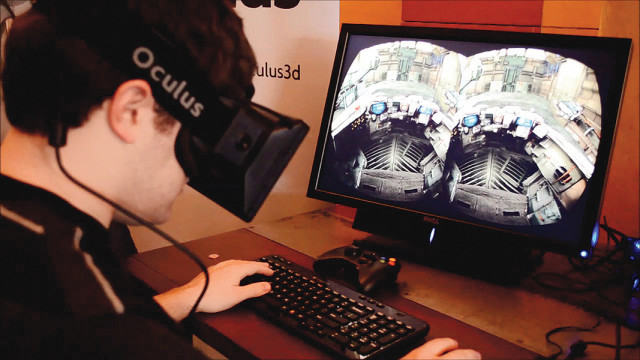Virtual reality: (D)rifting apart?
What Facebook’s latest billion dollar purchase means for gaming junkies.

What Facebook’s latest billion dollar purchase means for gaming junkies.
Oculus Rift is a clunky looking head-mounted device that looks like a pair of night vision goggles from the back, and a small wearable box from the front. It features a high-speed LCD display that is powered by two lenses capable of delivering a highly immersive stereoscopic 3D perspective. The device’s extraordinary 90 by 110 degrees field of view (FOV) means that the person wearing it is effectively unable to see little else aside from what Oculus Rift shows them, because the rest of their vision is blocked by the virtual FOV. This results in fewer distractions outside of the virtual reality experience.

Gamers who have played videogames on the VR headset have reported an extraordinary experience like no other, whereby looking up they see the virtual sky, and by looking down they see their animated feet and the virtual ground they walk on. Oculus Rift already boasts compatibility with countless bestselling video games, including the Half-Life series. The darling of the videogame industry, Valve Corporation, also recently announced a VR mode for their 75 million-user strong PC gaming platform, Steam. Among other things, Steam VR will allow Oculus Rift users to browse through the Steam platform in virtual reality. But of course, the biggest nod Oculus Rift received with regards to its potential was when renowned American game programmer John Carmack (Doom) joined their team.
The device’s potential is not limited to videogames as it has also been used in some instances to satisfy physical needs. In theory, this may sound distasteful to some, but is a testament to its extraordinary level of immersion. Other real world applications of the device include urban planning, design, manufacturing, flight and military training, and the treatment of phobias.
Initially, the biggest hurdle Oculus Rift faced was motion sickness. As recently as 2012, users with no prior history of motion sickness reported intense headaches and nausea only after minutes of using the device. This resulted in improvements in motion tracking and higher frame rates designed to counter the issue.
Oculus VR’s acquisition by Facebook has many gamers raising their pitchforks. Twitter, message boards, and blogs have been set on fire by gamers whining about how the move will mean the death of the product at the hands of the social networking giant. This false sense of entitlement is especially comical considering that at best, gamers have merely invested their time in following the device’s development, while Facebook has actually invested a large sum of money in its future. By mishandling the product, Facebook would have a lot more to lose than the gamers, and it is unlikely that Mark Zuckerberg will risk alienating the core audience of the VR headset by shifting the primary focus of the device.
If anything, my concern is regarding the device itself. Unless its issues with motion sickness are completely wiped out, Oculus Rift could be in for a rocky future. Moreover, the failure of 3D TVs and the lukewarm reception to Google Glass has shown that consumers don’t like wearing silly head devices for long periods of time. Will we be more receptive to Oculus Rift? Well, that’s the real billion dollar question.
Noman Ansari is a freelance writer and a regular contributor to several publications.He tweets @Pugnate
Published in The Express Tribune, Sunday Magazine, April 6th, 2014.



















COMMENTS
Comments are moderated and generally will be posted if they are on-topic and not abusive.
For more information, please see our Comments FAQ